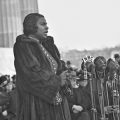An historic journey
In 2015, our nation will commemorate two defining transformational events—the 150th anniversary of the abolishment of slavery, and the 50th anniversary of the Voting Rights Act. That same year the Smithsonian is committed to bringing our newest museum to fruition—the National African American Museum of History and Culture. It will also be 100 years since a group of black Civil War veterans first proposed an African American memorial on the National Mall. The journey has been long and arduous and it took many people to get us here.
This museum is deeply personal to me, as I grew up in the Deep South during segregation and saw firsthand the tragedy it brought. Later, as a Georgia Tech student, I lived in Atlanta when it was one of the few southern cities to embrace the changes sought by the civil rights movement. Atlanta took as its motto, “The city too busy to hate,” and as a result it experienced an economic revival by offering opportunity to everyone. The lesson is simple: allowing everyone to fully participate in society is fundamental to the American Dream. It’s why this museum is so important, and why we look forward to breaking ground for it this month. But as founding director Lonnie Bunch has noted, although the museum building hasn’t yet been constructed on the National Mall, NMAAHC is already a living, thriving entity.

African American Civil War soldier, 1856-1861, collection of the National Museum of African American History and Culture
Museums humanize history through their collections. Much of the preparation for NMAAHC’s opening has entailed acquiring artifacts to help tell the individual stories of African American life, from the renowned to the anonymous. More than 20,000 objects have already been gathered. Some are inspiring, such as the Spirit of Tuskegee, an actual WWII training plane used by the Tuskegee Airmen. Others are illuminating, like the photo albums of 19th-century middle-class African Americans that offer a revealing glimpse into an often invisible population. Still others are bittersweet, such as NMAAHC’s first collected item, a Croix de Guerre medal, the French equivalent to the U.S. Medal of Honor. It was one of those awarded to the all-black 369th infantry regiment, the valiant “Harlem Hellfighters,” who spent more time on the front lines than any other unit during WWI, but whose valor was ignored when they returned home. These are some of the collections that form the backbone of NMAAHC’s mission to tell these uniquely American stories.
Building communities

Henry Clay Anderson Photographs, Greenville, Mississippi – Photo courtesy Henry Clay Anderson Collection © Smithsonian National Museum of African American History and Culture.
At NMAAHC’s inception, when there were zero objects in the collection and only two employees, we knew that community outreach would be critical to making this museum a reality. One of our signature programs is the preservation initiative “Save Our African American Treasures.” In collaboration with cultural institutions and community leaders in many cities, we have asked people to share their personal mementos, diaries, letters, photographs, and other precious objects that have been passed down by their ancestors, as well as the oral histories of those objects. By doing so, we will get a clearer sense of their historical and cultural significance and give families the tools to preserve and pass on these tangible bits of the past.
NMAAHC staff have also conducted numerous educational workshops and public programs including symposia, film screenings and book signings. Corporate and cultural partnerships have expanded our capacity to reach people, and the museum now has more than 10,000 members. I know they are as eager as I am to see the completed museum.
A Symbol in Stone
Between the National Museum of American History and the Washington Monument, the museum’s prominent location will be a symbolic reminder that African American history and culture is not simply a footnote in the book of American history—it is integral to every chapter.

Shards of stained glass and a shotgun shell recovered after the 1963 bombing of the 16th Street Baptist Church that killed for girls in Birmingham, Ala. Gift from the Trumpauer-Mulholland Collection
- The building’s design will reinforce the themes of hope and resilience, which will be seen in its African art-inspired three-tiered crown, its shimmering cladding that will let daylight in and light up the night with an amber glow, and a breathtaking interior space that will draw the eye to the heavens. The porch will create a welcoming space to afford a magnificent vista looking out over the Mall.
Not only beautiful, NMAAHC will be a 21st-century model of sustainability. If all goes as planned, the Smithsonian’s 19th museum will be the first to be certified by the U.S. Green Building Council for Leadership in Energy and Environmental Design (LEED Gold), setting a green standard on the Mall and serving as a sustainable icon for generations to come.
Together We Rise
Throughout history, our nation has flourished when we have put aside our differences for a common goal. The National Museum of African American History and Culture will be a testament to that truth. It will remind us that the threads of the African American experience are forever stitched into the American quilt; you simply cannot adequately tell the story of America without a full account of the contributions made by African Americans. NMAAHC will also stand as an enduring monument to all those who have fought for civil rights, helping to perfect our union and leaving a legacy of a more diverse, more equal nation. As Maya Angelou said, “In diversity there is beauty and there is strength,” and I can think of no greater fulfillment of that sentiment than this museum.
We hope you will all follow the progress of our newest addition to the Smithsonian family as we break ground this month. In 2015, join with us to remember those who sacrificed, reflect on the remarkable progress we’ve made, and rejoice for the promise of Dr. King’s American Dream.

View from Constitution Ave. sidewalk looking south along the Promenade Path. (Image courtesy Freelon Adjaye Bond SmithGroup)
Posted: 6 February 2012
- Categories:






